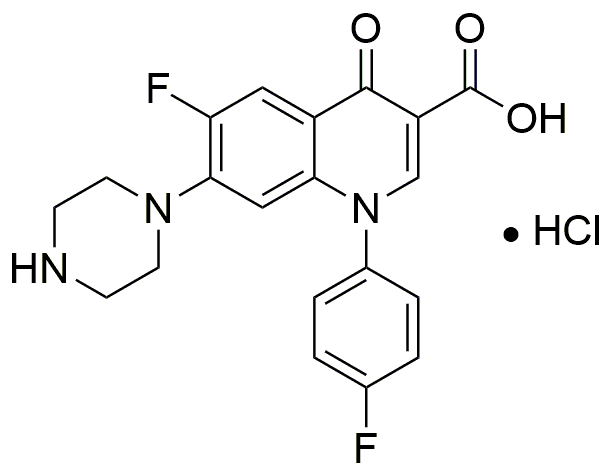Sarafloxacin hydrochloride is widely utilized in research focused on:
- Veterinary Medicine: It is primarily used as an antibiotic in livestock to treat bacterial infections, ensuring healthier animals and safer food products.
- Pharmaceutical Development: Researchers explore its efficacy and safety profiles, contributing to the development of new antimicrobial agents.
- Microbiology Studies: It serves as a model compound in studies investigating bacterial resistance mechanisms, helping scientists understand and combat antibiotic resistance.
- Food Safety: Used in studies assessing the impact of antibiotics on foodborne pathogens, it aids in developing better food safety protocols.
- Environmental Research: Investigated for its effects on aquatic ecosystems, providing insights into the environmental impact of veterinary pharmaceuticals.
General Information
Properties
Safety and Regulations
Applications
Sarafloxacin hydrochloride is widely utilized in research focused on:
- Veterinary Medicine: It is primarily used as an antibiotic in livestock to treat bacterial infections, ensuring healthier animals and safer food products.
- Pharmaceutical Development: Researchers explore its efficacy and safety profiles, contributing to the development of new antimicrobial agents.
- Microbiology Studies: It serves as a model compound in studies investigating bacterial resistance mechanisms, helping scientists understand and combat antibiotic resistance.
- Food Safety: Used in studies assessing the impact of antibiotics on foodborne pathogens, it aids in developing better food safety protocols.
- Environmental Research: Investigated for its effects on aquatic ecosystems, providing insights into the environmental impact of veterinary pharmaceuticals.
Documents
Safety Data Sheets (SDS)
The SDS provides comprehensive safety information on handling, storage, and disposal of the product.
Product Specification (PS)
The PS provides a comprehensive breakdown of the product’s properties, including chemical composition, physical state, purity, and storage requirements. It also details acceptable quality ranges and the product's intended applications.
Certificates of Analysis (COA)
Search for Certificates of Analysis (COA) by entering the products Lot Number. Lot and Batch Numbers can be found on a product’s label following the words ‘Lot’ or ‘Batch’.
Numéro de catalogue
Numéro de lot/série
Certificates Of Origin (COO)
This COO confirms the country where the product was manufactured, and also details the materials and components used in it and whether it is derived from natural, synthetic, or other specific sources. This certificate may be required for customs, trade, and regulatory compliance.
Numéro de catalogue
Numéro de lot/série
Safety Data Sheets (SDS)
The SDS provides comprehensive safety information on handling, storage, and disposal of the product.
DownloadProduct Specification (PS)
The PS provides a comprehensive breakdown of the product’s properties, including chemical composition, physical state, purity, and storage requirements. It also details acceptable quality ranges and the product's intended applications.
DownloadCertificates of Analysis (COA)
Search for Certificates of Analysis (COA) by entering the products Lot Number. Lot and Batch Numbers can be found on a product’s label following the words ‘Lot’ or ‘Batch’.
Numéro de catalogue
Numéro de lot/série
Certificates Of Origin (COO)
This COO confirms the country where the product was manufactured, and also details the materials and components used in it and whether it is derived from natural, synthetic, or other specific sources. This certificate may be required for customs, trade, and regulatory compliance.


